
In response to growing concerns about children’s mental and physical health, state policymakers have enacted laws to require schools to take an active role in supporting their students’ wellbeing – from requiring a minimum amount of time dedicated to physical activity, to requiring access to clean, potable water, to providing access to mental and physical health services, to implementing a range of preventative dental, vision, and health screenings. As schools reopen this fall to the new realities of the COVID-19 pandemic, with many shifting to virtual learning for at least part of the school week, they will be challenged to implement many of these requirements. Schools, and the communities they serve, must find new ways to support students’ social, emotional, and physical health needs, which are typically addressed within the school building.
Schools play a critical role in ensuring access to mental and physical health services. This is particularly true for low-income students and students of color who may face systemic barriers that make it difficult to access critical health resources and services. In one study, students in Boston Public Schools were nearly eight times more likely to see a school nurse than a pediatric care provider. In another study, nearly 80 percent of children receiving mental health services did so at school. It is no surprise, then, that state policymakers have leveraged schools to help address child health crises, including the childhood obesity epidemic and rising rates of child and teen suicides.
In 2019, my organization, Child Trends, with our partners from the National Association of State Boards of Education (NASBE), the Institute for Health Policy Research at the University of Illinois at Chicago, and EMT Associates, Inc., documented the broad landscape of laws addressing student wellbeing in schools. We found that every state requires schools to attend to student health in at least some way when considering each of the ten elements of the Centers for Disease Control and Prevention’s Whole School, Whole Community, Whole Child framework (see image below). These laws, however, presume that schools operate in a typical manner – with students in school buildings without pandemic-related restrictions. Yet, we know this will not be the reality for many schools starting in fall 2020.
When schools closed at the beginning of the pandemic, most were ill-prepared to continue even basic academic operations in a remote environment, let alone provide health supports. Though nearly every state has laws that provide guidance around a school’s role during a contagious disease outbreak, most focus on procedures for when individual students or educators contract an illness; only five states (Arkansas, Maine, Ohio, Pennsylvania, and Utah) have laws that include recommendations or requirements for distance or virtual learning in case schools close due to disease outbreaks and only two (Georgia and Oregon) have laws that provide for the continuation of school services (e.g., meals) in the event of closure due to pandemic. In developing these policies, schools’ and state policymakers’ immediate concern was creating plans and procedures for the continuation of academic learning as well as the provision of school meals.
Some states have since issued broader guidance on providing mental health services and ensuring continuance of care particularly for students with chronic health conditions, among other issues. However, there are still many health-related supports and services schools administer – such as physical education and regular health screenings – which are challenging to bring back for schools implementing pandemic-related social distancing recommendations. Though our collective attention may currently focus on preventing the spread of COVID-19, the many issues state policymakers set out to address through school health mandates are not going away and, in many cases, could be exacerbated by the pandemic; emerging studies suggest that childhood obesity rates may be rising as a result of pandemic lockdowns, and many fear an increase in suicide. Moreover, there are strong links between all elements of students’ well-being and academic achievement; neglecting student health could lead to further academic losses.
As schools reopen, they must find ways to continue supporting students’ wellbeing. This may mean prioritizing using in-school days to implement health screenings and provide health services, creating broader partnerships with community organizations, better utilizing telehealth, and organizing socially-distant physical activities. Finding adequate solutions will necessarily require some trial and error as there is no precedent for this pandemic. The first step is for schools to recognize their role in supporting students’ health during this time. Schools should take stock of all the services they typically provide and plan accordingly. One place to start is Kaiser Permanente’s Thriving Schools’ School Reopening Playbook, which provides guidance on just some of the services schools need to consider as they open in this new reality.
